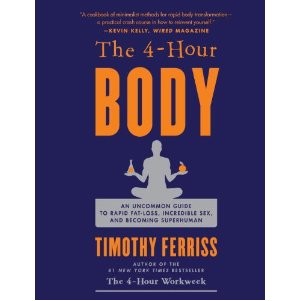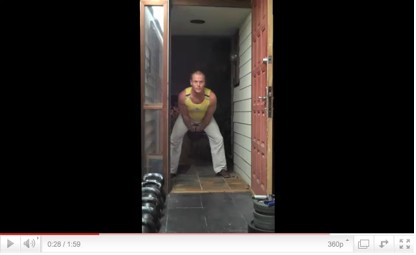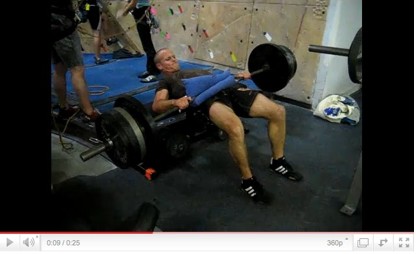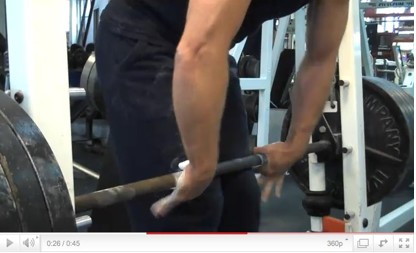Interview with Tim Ferriss, RKCII
about Kettlebells, Preparation for the RKC course, and his New Book The 4-Hour Body
Tim Ferriss, RKCII
December 14, 2010 09:40 AM

Tim Ferriss, one of Fast Company's "Most Innovative Business People of 2007," is author of the #1 New York Times, Wall Street Journal, and BusinessWeek bestseller,
The 4-Hour Workweek, which has been published in 35 languages.
WIRED magazine has called Tim "The Superman of Silicon Valley" for his manipulation of the human body. He is a tango world record holder, former national kickboxing champion (Sanshou), guest lecturer at Princeton University, and faculty member at Singularity University, based at NASA Ames Research Center.
His new book, which includes more than 10 years of experimentation, is
The 4-Hour Body. In it, you'll see kettlebells and a number of familiar names, including Pavel, Tracy Reifkind, Zar Horton, and Gray Cook.
http://www.youtube.com/watch?v=LIVmsIJyj3A
 Tim, when were you first exposed to kettlebells? Was it love at first sight?
Tim, when were you first exposed to kettlebells? Was it love at first sight?Ha ha ha... I wish. It would've saved me a lot of time.
It started in 1999, when I made weekly pilgrimages from Princeton University to Philadelphia, where I trained at a gym called Maxercise. For the 45-minute workout that justified the trip, I was commuting more than two hours. Steve Maxwell, the owner of Maxercise, was a six-time Pan-American gold medalist in Brazilian jiujitsu (two world championships came later), and his clients ranged from the FBI and Secret Service to the Phillies and the Dodgers.
I first met kettlebells on a frigid winter evening in Maxercise's second-floor torture chamber. They were generally reserved for fighters and aspiring strong men. Here's the sad part: I abandoned kettlebells after two sessions, largely because I thought the workouts and movements needed to be complicated.
It wasn't until six years later, through MMA fighters, that I realized how simple kettlebells could be: the swing.
From 2005-2006, I used one 24kg Dragon Door kettlebell as the center of my athletic training. I did almost nothing but two-arm swings, and the results and transfer to BJJ -- I trained at the Ralph Gracie Academy in Mountain View -- were incredible.
Now you're RKCI and RKCII certified—what compelled you to take it further? Any tips for aspiring RKCs?To be perfectly honest, it was less about the tool -- the kettlebell -- and more about the methodology. Allow me to explain:
RKC was the most systematic approach I found for acquiring the skill of strength. This includes everything from biomechanics and leverage to programming. There aren't many certs where you can see someone go from pressing a 24kg bell to a 40kg bell in three days.
The principles of maximal strength that I learned and practiced at RKC apply to barbells and dumbbells -- and the playing field -- as much as they apply to kettlebells. Kettlebells are, however, a fantastic vehicle for learning the principles because, in general, you get more feedback. This is especially true with a diagnostic like the TGU.
For aspiring RKCs, here are some tips. I focus on the snatch test, as that's where many people fail:
1) Focus on the swing first. Your snatch will only be as strong as your swing. I've worked up to 50+ continuous reps with the Beast. It's harder to "snap" with the Beast than the 24kg! You'll notice about 20 DD KBs lining the hallway:
http://www.youtube.com/watch?v=9Hmw-GYqEng 2) Transfer goes both ways.
2) Transfer goes both ways. Kettlebells help the deadlift, for example (I put 150 lbs. on my 1RM), but barbell exercises also help swings/snatches. I used supine hip thrusts on a bench 1x/week to help me prep for RKCII. Here is a demo of the exercise, using 425 lbs. x 5:
http://www.youtube.com/watch?v=2MaRla9RhW4
If your hands are your weak point, as was true for me, or you have trouble cleaning heavier weights, I found rack pulls for 2-3 reps to be very helpful. Here is six plates x 2, and note the double overhand grip, which is not a hook grip:
http://www.youtube.com/watch?v=WL1XD81hYk0 3) Follow a technical progression.
3) Follow a technical progression.- Once you can do 100 continuous swings with your snatch test weight, move on to the high-pull-to-punch technique for the snatch. Important: practice the "punch through" at chest height before going overhead.
- The downswing is what will tear your hands -- use the "corkscrew" method in the beginning to avoid casting forward.
- The thumb knuckle should be pointed straight back between your legs when the KB passes your legs on the downswing. Knuckles facing forward = tearing calluses after 60 reps for most people.
- If you have shoulder problems (I had reconstructive surgery on my left), reach full extension overhead when the center of the KB is about 6" ahead of center of your forehead. Then move your thoracic and head forward, as with maximal barbell pressing, to stabilize the KB at the finish.
- In the test itself, don't use too much chalk if you're outside and sweating a lot. It will become glue, in effect, and paradoxically tear off all of your skin.
- During the cert, forget taping horizontally across the palm. It will slide and become a nightmare. Go vertically from a wrist wrap, up around each finger, one at a time, until you cover your entire hand. Technique courtesy of Master RKC Mark Reifkind. This is the only reliable method I've found, and I've tested them all.
- Train as you will test: I suggest 15 reps one arm, 15 reps the other, then 10 reps per side until 100.
4) Don't prepare for RKC as a class; train for it as a competition.Many would-be RKCs fail due to A) overtraining, and B) not factoring in nutrition/supplementation.
In preparation for RKCII, I trained 3x/week, never more than 30 minutes each. In general, I was using a minimalist approach that looked like the following, excluding minimal warm-ups (X-band walk for glute medius, glute bridging, static hip flexor stretches):
MONDAY
- Overhead clean and press: 3 sets x 2 (90-95% 1RM) with 5min rest between
- Static holds at the top position of the tactical pull-up: 10sec x 3, followed by 30sec in handstand
WEDNESDAY
- Barbell supine hip thrusts: 3 sets x 3 (90-95% 1RM)
- (Alternate weeks: Sumo deadlift to the knees, 3 sets x 2-3 (90-95% 1RM)
- Kettlebell swings: 1 set of 30-50 with max weight
FRIDAY
- Overhead clean and press: 3 sets x 2 (90-95% 1RM) with 5min rest between
- Static holds at the top position of the tactical pull-up: 10sec x 3, followed by 30sec in handstand
That's about it. Yes, really.
Three weeks out, I inserted two days between workouts, then effectively took the last week off. I PR'd in every test I took at RKCII. You don't need to train 8-10 hours a day to prepare for a cert that lasts 8-10 hours a day.
This is true even for running 100-mile races -- one of the trainers in
The 4-Hour Body, who uses Westside-like training to prep for ultra-endurance, seldom runs more than 5 miles in training. Usually, it's multiple 100-400-meter repeats! Less than six hours A WEEK of training for an event that often last more than 24 hours.
Barry Ross, who's also in the book, often quotes famed track coach, Henk Kraaijenhof: "Do as little as needed, not as much as possible." These words should be remembered.
On to a few nutritional points.
First, if you can, do a glycogen-depletion workout about one week prior to your RKC. Immediately afterward, carbohydrate load using something like GENR8 Vitargo S2, then move to meals for 36 hours that are roughly 4:1 ratio of carbs to protein. After that, I suggest following something resembling a Paleo diet including legumes/beans.
Both prior and during the cert, I also utilized supplements like beta-alanine. B-alanine, unlike creatine monohydrate, allowed me to increase anaerobic output without increasing bodyweight, which was important, as RKCII had weight-classes.
Here's a video taken at in my hotel at RKCII, which shows some of my supplementation and hand-care after tearing (which I planned on).
 The 4-Hour Body
The 4-Hour Body is the result of an obsessive quest, spanning more than a decade, to hack the human body. It contains the collective wisdom of hundreds of elite athletes, dozens of MDs, and thousands of hours of jaw-dropping personal experimentation. From Olympic training centers to black-market laboratories, from Silicon Valley to South Africa, Tim Ferriss, the #1
New York Times bestselling author of
The 4-Hour Workweek, fixated on one life-changing question:
For all things physical, what are the tiniest changes that produce the biggest results?It's all here, and it all works.
YOU WILL LEARN (in less than 30 minutes each):* How to prevent fat gain while bingeing (X-mas, holidays, weekends)
* How to increase fat-loss 300% with a few bags of ice
* How Tim gained 34 pounds of muscle in 28 days, without steroids, and in four hours of
total gym time
* How to sleep 2 hours per day and feel fully rested
* How to go from running 5 kilometers to 50 kilometers in 12 weeks
* How to reverse "permanent" injuries
* How to add 150+ pounds to your lifts in 6 months
And that's just the tip of the iceberg. There are more than 50 topics covered, all with real-world experiments, many including more than 200 test subjects.
You don't need better genetics or more discipline. You need immediate results that compel you to continue.
That's exactly what
The 4-Hour Body delivers.
Back